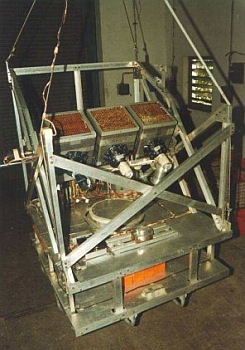Purpose of the flight and payload description
LASE (Large Area Scintillation counter Experiment) is a balloon-borne payload developed at the Tata Institute of Fundamental Research from India to detect microsecond variations in the flux of X-ray sources in hard X-ray energy region upto 200 keV.
The X-ray gondola is shown in the figure at left and consists of the three detector telescope, payload electronics, PCM encoder, telecommunication package, X-ray source tracker and the orientation platform. The back-to-back geometry conceived for LASE consists of a combination of thin and thick sodium iodide detectors. Each of the detector modules has a geometrical area of 400 cm2 and consists of a 3 mm thick single crystal placed above a similar detector of 30 mm thickness and the two crystals are optically decoupled by a thin aluminum foil. An schematic diagram of the detector and the arrangement of the diffuse box with three phototubes attached to each module is shown clicking in the image at left.
A 1.0 mm thick glass window is provided for the thin crystal which also acts as an entrance window for the X-ray photons. The glass window attenuates ~40% of the X-rays at 20 keV. Main detector is seen by two 5" EMI 9530 phototubes using a diffuse box arrangement. The bottom detector is viewed by a directly coupled 5" phototube. The top of the diffuse box is aluminum-coated black paper so as to avoid further attenuation of the incoming flux. Entire diffuse box is surrounded by 1 mm thick lead so as to provide passive shielding for the background photons. The field of view of each module is 4.6° x 4.6° and is defined by a demountable 1.3 mm thick slat collimator made with a sandwich of Cu + Sn + Pb + Sn + Cu which is effective up to 250 keV.
Each detector module in LASE experiment is designed as a stand alone unit. The front end on board electronics for each unit consists of three pre-amp and amplifier units and a event selection logic. Signals from all the three phototubes in each module are amplified separately and fed to the event selection logic and flag-generator. The selection criterion used is that both phototubes viewing main crystal from the diffuse box must register a coincident signal above the noise-threshold and there should not be any pulse in the veto-counter. Selected events are then pulse-height analyzed and the corresponding arrival time of these events is stored simultaneously. The condition of coincident signal from two tubes of the main detector is very effective in suppressing the random noise of the phototubes and the low level radio interference.
The attitude control and pointing system for LASE is a biaxial configuration (alt-azimuth mount) which is servo stabilized with reference to Earth's magnetic field. The detectors along with high voltage supply and corresponding pre-amp +amp box are mounted on a cradle fitted on the elevation axis within the gondola which is controlled in azimuth by a combination of anti-twist motor between the balloon and the gondola and the torque of a heavy reaction wheel with respect to gondola frame. The cradle is supported by two elevation bearings and is attached to a horizontally mounted lead screw by a shaft with flexible ends. The elevation of the detectors with respect to the vertical is controlled by a DC motor attached to the lead screw along with a shaft encoder read-out. An independent high resolution inclinometer mounted on the cradle provides verification of the detector movement.
The tracker system consists of a 8085 on-board microprocessor which calculates the instantaneous position of any given X-ray source. The pre-processed coordinates of various target objects are stored in an EPROM as the source library in the form of a look-up table along with flight-plan look-up table. Each source can be identified using its sequence code number.
Details of the balloon flight
Balloon launched on: 12/17/2003
Launch site: TIFR National Balloon Facility, Hyderabad, India
Balloon launched by: National Balloon Facility, Tata Institute of Fundamental Research
Balloon manufacturer/size/composition: Zero Pressure Balloon Antrix - 422,149 m3
Flight identification number: 461
End of flight (L for landing time, W for last contact, otherwise termination time): 12/17/2003
Payload weight: 648 kgs
External references
- Balloon launch records Tata Institute of Fundamental Research
- Mechanical properties of ANTRIX balloon film and fabrication of single cap large volume balloons Advances in Space Research 42 (2008) 1691
- Scientific ballooning in India - Recent developments Advances in Space Research, Volume 37, Issue 11, p. 2015
- Search for pulsations in the low mass X-ray binary Sco X-1 29th International Cosmic Ray Conference, Volume 4, p.183 (2005)
2756If you consider this website interesting or useful, you can help me to keep it up and running with a small donation to cover the operational costs. Just the equivalent of the price of a cup of coffee helps a lot.


